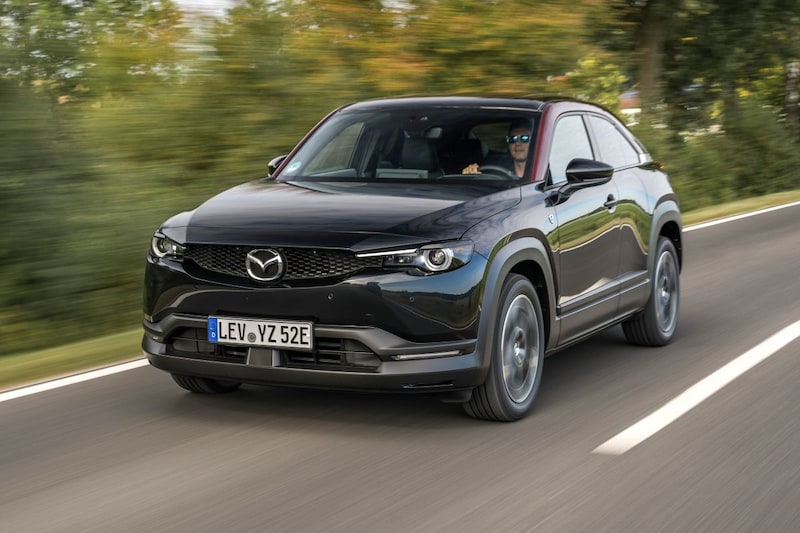We drive the Mazda MX-30 R-EV, electric with a Wankel engine as a range extender. A lot more practical with unique technology.


The electric performance of the Mazda MX-30 is not exactly groundbreaking. Mazda has now come up with an answer and is giving the car a range extender based on a Wankel engine. Unique technology, but what do we gain from it?
What is a range extender?
The Mazda MX-30 R-EV is in principle the same as the fully electric MX-30, but with the addition of its own power plant based on a combustion engine. The combustion engine is a rotary engine like the one Mazda used in the past in the iconic RX-7 and RX-8. Mazda even won the 24 Hours of Le Mans with it. The combustion engine forms the heart of a generator that generates extra electricity to charge the battery or supply the electric motor with extra electricity while driving. The combustion engine is not connected to the wheels. As with the BEV, the drive is entirely provided by the electric motor. The principle is similar to what we saw at the time with the BMW i3 REX.

In the Mazda MX-30 R-EV, the Wankel engine does not drive the wheels, the electric motor does that on its own.
Does the extra technology come at the expense of space?
A look under the hood shows that it has become a lot fuller there. In the previously empty space next to the electric motor hidden under the power electronics there is now a generator that is driven by a single-disc rotary motor, also popularly referred to as the Wankel motor. The housings of the various components are bolted together, but the combustion engine is not connected to the wheels. The neatly finished interior of the R-EV is the same as that of the BEV, and that means a clear and user-friendly dashboard. You have plenty of space in the front and seats with seats that are slightly too short. You board at the rear via the suicide doors, provided you fit in the back. The easily accessible luggage compartment measures a modest 350 liters. That’s all just like with the BEV.

All technology is under the hood of the Mazda MX-30 R-EV. The interior remains unchanged.
How far can you get with the Mazda MX-30 R-EV?
The first electric Mazda does not immediately push boundaries. In fact, the MX-30 presented in 2020 should be able to travel 200 km on a full battery, according to WLTP. In practice, however, we do not get much further than 170 km and the modest battery can only be charged with a maximum of 50 kW direct current. A 50 liter petrol tank has been added to the Mazda MX-30 R-EV with its range extender. To accommodate it, the battery has become smaller, so that your stated electric range is only 85 km. In practice it is about 70 km. But… with a full battery and a full tank you should now be able to travel 680 km according to WLTP, more than three times as far as the BEV.

The generator can recharge the battery while driving.
How does this special technology work out in practice?
With its 170 hp and 260 Nm, the Mazda keeps up with traffic smoothly. Even when we get close to the top speed, the engine still shows sufficient zest for life. And that in peace and quiet. The MX-30 is a fairly quiet car. However, that changes when the petrol engine takes action. The engine produces a characteristic and clearly present hum. And although Mazda has done their best to link the speed of the rotary engine to the speed of the car, they do not increase (or decrease) in complete unison. This creates an effect that is reminiscent of an old-fashioned vending machine without a lock-up. Every now and then it is not disturbing, we even find it a bit fun, but on longer trips it starts to get boring.

Occasionally you hear the characteristic Wankel engine sound.
How does the series hybrid Mazda drive?
The car has become 130 kg heavier but feels lighter than the 1,853 kg it weighs. Because extra weight has been added under the hood, we notice on wet roads that the car – partly thanks to the relatively narrow tires – moves around the outside bend quite easily over the front wheels. It’s a little thing. For the rest, there is not much to criticize about the chassis, Mazda has found a very nice balance in the suspension. The car is very stable on the road, even when the pace increases to top speed.

The MX-30 R-EV has a nice, stable chassis.
How much will such a range extender cost me?
Financially, the R-EV is well in line with the BEV. Because there is a combustion engine and therefore CO2 is emitted, BPM is charged for cars in the Netherlands. However, that amount is a modest €550. Without tax, the price difference between the two powertrains is only 3 euros. As a result, the purchase price of the R-EV is only slightly higher than that of the BEV. And with that you buy a car that should be able to go more than three times as far with a full battery and ditto petrol tank. However, you do not benefit from the SEPP, the Subsidy Scheme for Electric Passenger Cars for Private Individuals.











